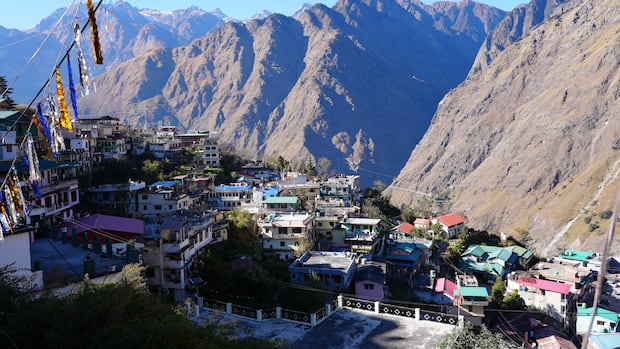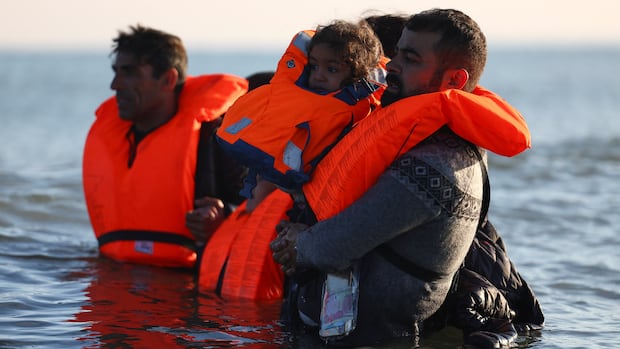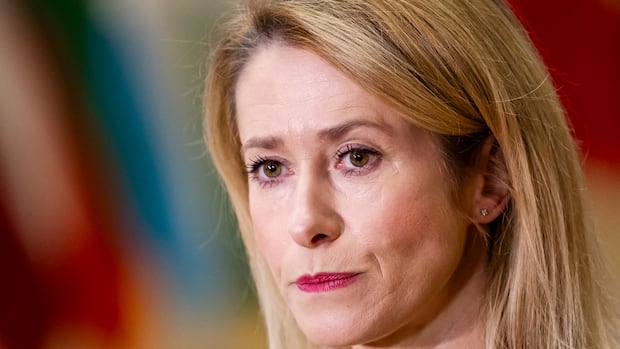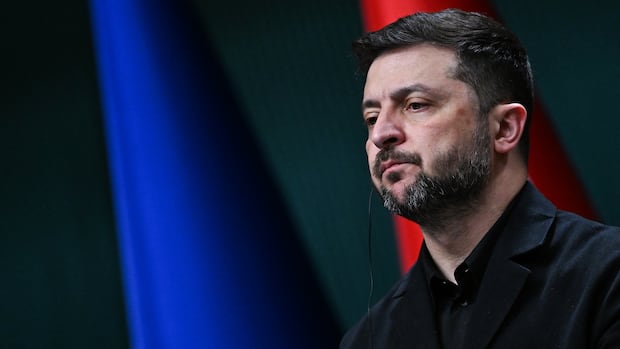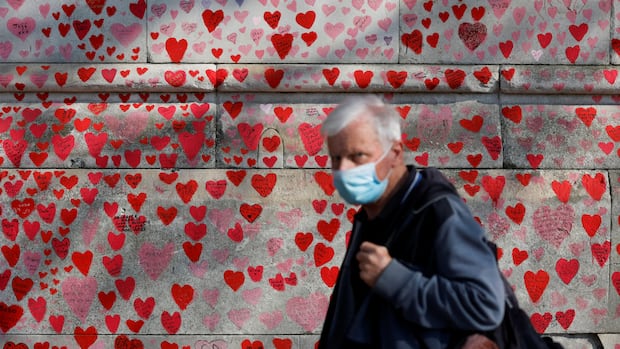Inside her tent in Gaza City, Reda Aliwa has prepared a meal for her grandchildren — all 36 of them. They push and pull each other while crowding around her, and one by one, she offers them each a spoonful of rice.
The younger ones call out for the next serving — “Me, grandma, me!” This is all the food they’ll eat tonight, and some of the children swipe clumps of rice when Aliwa’s attention is elsewhere. She sends one of the boys to fetch something to drink from a container behind their tent that’s been filling with rainwater. She passes a metal cup down a line of kids, one sip for each.
“My children took care of me,” Aliwa said. “Today, I am caring for their children … but the burden is too big for me to carry.”
Aliwa’s five children were killed in two attacks that took place four days apart this September while they were sheltering at a camp in Gaza City.
Now the 60-year-old and her husband are the only ones left to care for their grandchildren as they try to rebuild their lives amid a fragile ceasefire. The children are among some 40,000 kids in Gaza who've lost one or more parents, according to an April report from the Palestinian Central Bureau of Statistics (PCBS), which called it “the largest orphan crisis in modern history.”
But Alex Saieh, the head of humanitarian policy and advocacy for Save the Children International, says that number is likely underreported.
“We won’t know the extent of the destruction or the deaths for a while,” she said referring to the limited access humanitarian organizations have had in Gaza.
 Aliwa says she depends on food distributions that are few and far between to feed her grandchildren. (Mohamed El Saife/CBC)Unreliable food distribution
Aliwa says she depends on food distributions that are few and far between to feed her grandchildren. (Mohamed El Saife/CBC)Unreliable food distribution Aliwa was also injured in one of the attacks and ended up in a coma.
When she woke, she wailed as her husband told her that her children had died. But soon after, she left the hospital against the advice of her doctors because she was so worried about her grandchildren.
“I left when I could barely walk,” she told CBC freelance videographer Mohamed El Saife. “The only thing I had on my mind was the children.”
All of her grandchildren, who range in age from a year and a half to 17, survived the attacks. Soon, the reality of the burden she and her husband faced set in.
They don’t have jobs or money, so the family relies on food distributions, but she says finding enough to eat is still very difficult.
“I get whatever I can,” she said. “One day I find [something] and 10 days I don’t find anything.”
Saieh says though NGOs provide some financial assistance, prices are still too high for any of that money to go very far because aid is only trickling into the enclave.
“You’re completely relying on humanitarian assistance that is in and of itself unreliable,” Saieh said.
 Aliwa worries about what will become of her grandchildren if something happens to her. She says without her and her husband, they would become street children. (Mohamed El Saife/CBC)Trauma, grief halt education
Aliwa worries about what will become of her grandchildren if something happens to her. She says without her and her husband, they would become street children. (Mohamed El Saife/CBC)Trauma, grief halt education Aliwa says before the war, some of the kids were at the top of their class, but schools and universities were bombed and education was no longer a priority. The children still haven’t been able to resume formal learning.
Her granddaughter, Ibtissam Aliwa, 13, bursts into tears when asked about her father, Mohamed.
“A month before he was martyred, life was beautiful,” she said. “And now, it stopped being beautiful.”
LISTEN | Front Burner — Portraits of childhood in Gaza:Front Burner30:54Portraits of childhood in Gaza
Today, if all goes well, a ceasefire will begin in Gaza. In phase one, Hamas has pledged to return all of the hostages, living and dead. For its part Israel will release hundreds of Palestinian prisoners, while withdrawing troops to an agreed-upon line in Gaza and maintaining majority control of the territory. Beyond that, the details of Trump’s promise of a “strong, durable, and everlasting peace” are fuzzy, but for hostage families and people in Gaza, it’s a reason to hope. Producer Allie Jaynes brings us a documentary that gives an on-the-ground perspective of what these past two years have been like for Gazans — especially for children. We hear from a 12-year-old with a popular Instagram “cooking show,” a girl living in a crowded displacement camp, and a music teacher giving lessons to kids all over Gaza to help them “escape the weight of war through the freedom of music.” We'd love to hear from you! Complete our listener survey here. [https://cbc.ca/FrontBurnerSurvey]Though NGOs have set up temporary learning centres for children that include psychosocial support, Saieh says there’s much left to be done to deal with the trauma Palestinian children carry.
The April PCBS report noted an almost total absence of social care and psychological support for children in Gaza.
“They experience deep mental disturbances, such as depression, isolation, and chronic fear, in the absence of safety and proper guidance,” the report said, adding that a lack of educational opportunities and social development leaves them vulnerable to child labour and exploitation.
 Aliwa worries about how she and her grandchildren will survive the future when they have so little to meet their basic needs. The tent they live in is damaged and has flooded in the recent rains. (Mohamed El Saife/CBC)Living near the yellow line
Aliwa worries about how she and her grandchildren will survive the future when they have so little to meet their basic needs. The tent they live in is damaged and has flooded in the recent rains. (Mohamed El Saife/CBC)Living near the yellow lineThe family lives in a tent in Gaza City amid mounds of rubble. They sleep on two mats Aliwa says she found on the street that are stained with blood. The tent itself is filled with holes and flooded during the recent rains.
When the children are asleep or distracted, Aliwa is able to deal with grief she carries with her. She has a collage of photos of her five children. Their smiles are bright and beaming, but they are a constant reminder of the great loss the family has endured.
Aliwa refuses to cry in front of her grandchildren. “If it gets too much and I feel my tears coming, I go to the side so they don’t realize how broken I am.”
The family currently lives near the yellow line — the boundary to which Israeli forces agreed to retreat under the ceasefire plan with Hamas. Aliwa says she hears explosions constantly as fighting continues on the other side.
Saieh says NGOs are calling for open borders, a continuous flow of aid into the strip and unimpeded access for humanitarian organizations.
She says it’s difficult to reach families sheltering in certain areas as streets are littered with unexploded ordnance and rubble.
“We need this pause to be definitive and for humanitarian organizations like ours to be allowed to do our jobs.”
 Aliwa says when her grief becomes overwhelming, she goes to a corner of the tent to cry so the children don't see her. (Mohamed El Saife/CBC)Worries about the future
Aliwa says when her grief becomes overwhelming, she goes to a corner of the tent to cry so the children don't see her. (Mohamed El Saife/CBC)Worries about the futureBack in Gaza City, after dinner, Aliwa's grandchildren gather near the fire to keep warm.
Some drop paper from a notebook into the fire to keep it going. Their grandfather fans the flames while Aliwa cleans up the tent and prepares for bedtime.
Though these daily tasks take up much of her time, Aliwa is also preoccupied with worries about the future.
WATCH | 'We can’t find anything to eat’: Palestinian children share their experience:What’s it like to be a kid living through a war? Working with CBC Kids News, freelance videographer Mohamed El Saife spoke to children living in Gaza City on Aug. 3. Gaza City is the largest city in Gaza, a Palestinian territory that has been devastated by an ongoing war between Israel and Hamas since October 2023. The children described the difficulties they’ve faced, like not being able to attend school, going hungry, losing their homes and seeing loved ones die. Some of the children have been using music to uplift their spirits and the spirits of those around them.“If something happens to me, what are all 36 supposed to do,” she asked. “They will be street kids.”
She also knows they’re struggling with issues like grief and trauma. When they ask about their parents, she tells them they are in Heaven.
“The young ones — the three and four year olds — say, ‘OK, grandma, let’s go to heaven now.’ ”



